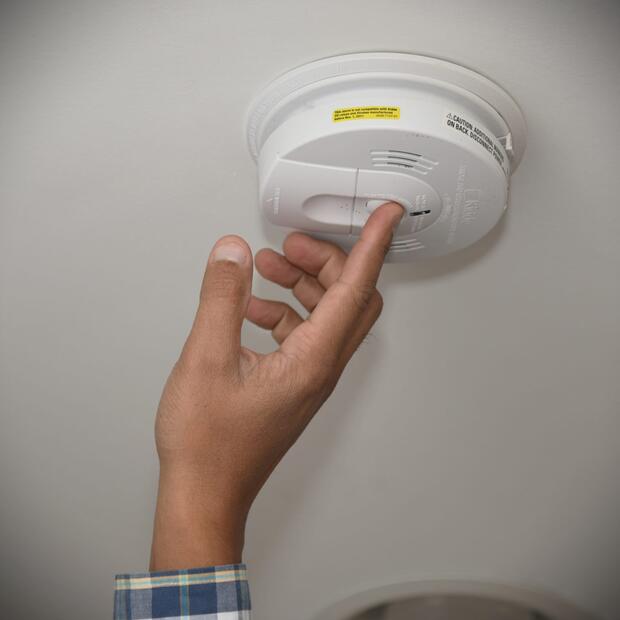Every home is required to have working smoke alarms and most are also required to have carbon monoxide alarms. Learn what kind you need to have and where they should be placed in your homes.
When purchasing new smoke or carbon monoxide alarms, be sure to choose alarms that are listed by a nationally recognized testing laboratory such as Underwriters Laboratories (UL) or Intertek (ETL). Avoid counterfeit alarms by selecting products from a well-known national brand.
Protect Your Home and Family with Smoke Alarms
- Install working smoke alarms on every level of your home, in each sleeping area, in the hallway outside bedrooms, at the top of open stairs, and at the base of cellar stairs.
- Maintain smoke alarms. Test them once a month. If your alarm begins "chirping," it's reached the end of its useful lifespan and must be replaced.
- When you change your clocks in the spring and fall, check the manufacturing date printed on the back of your alarms. Replace the alarm if it's more than 10 years old. If the alarm is not 10 years old and takes alkaline batteries, put in fresh batteries.
- The Massachusetts Fire Code requires that replacement battery-operated smoke alarms in most homes have a sealed, long-life battery and a "hush" feature. These modern alarms reduce the risk that someone will disable the alarm after a nuisance activation or to place the batteries in another device.
- Always choose alarms from a well-known, national brand that are listed by an independent testing lab such as UL or Intertek/ETL. Look for alarms that meet UL Standard 217, 8th Edition or later. These alarms use the latest multi-criteria detection technology to prevent nuisance alarms from cooking smoke.
- When disposing of an expired alarm with a sealed battery, don't place it in your household trash or recycling. These batteries can cause a fire if damaged in a compactor truck or transfer station. Instead, bring it to a household hazardous waste collection event in your community or visit www.call2recycle.org.
Smoke Alarms Save Lives Flyers
Smoke Alarms Save Lives - English
Smoke Alarms Save Lives - Spanish
Smoke Alarms Save Lives - Portuguese
Smoke Alarms Save Lives - Chinese
Smoke Alarms Save Lives - Vietnamese
Smoke Alarms Save lives - Haitian Creole
Smoke Alarms Save Lives - Russian
Smoke Alarms Save Lives - Arabic
Video: Dear Grandma PSA on Smoke Alarm Safety - English - 30 seconds
Skip this video Dear Grandma PSA on Smoke Alarm Safety - English - 30 seconds.Protect Your Home and Family with Carbon Monoxide Alarms
- The law requires carbon monoxide alarms to be installed on every level of your home, including habitable portions of basements and attics, in most residences.
- On levels with sleeping areas, carbon monoxide alarms should be installed within 10 feet of bedroom doors.
- Carbon monoxide alarms may be
- Battery operated with battery monitoring
- Plug-ins with battery back-up
- Low voltage systems
- Wireless
- Qualified combination
- Replace carbon monoxide alarms every 5 to 7 years, depending on the make and model.
- Newer CO alarms have a 10-year sealed battery that does not need changing. At 10 years, the entire device is replaced.
- If you have a plug-in model, be aware that the battery will run down during an extended power outage and may need to be replaced.
For Landlords and Tenants
- Nicole's Law also requires landlords to install and maintain carbon monoxide alarms in every dwelling unit that has a source of carbon monoxide.
- Large apartment buildings, where there is no source inside of the individual apartments, may use an alternative method to detect carbon monoxide near the furnace, boiler rooms, or garage.
Additional Resources
- Carbon Monoxide (CO) Safety
-
Open PDF file, 160.97 KB, Carbon monoxide safety pamphlet in English (English, PDF 160.97 KB)
-
Open PDF file, 175.42 KB, Carbon monoxide safety pamphlet in Spanish (English, PDF 175.42 KB)
-
Open PDF file, 178.21 KB, Winter carbon monoxide safety pamphlet in English (English, PDF 178.21 KB)
-
Open PDF file, 185.28 KB, Winter carbon monoxide safety pamphlet in Spanish (English, PDF 185.28 KB)
